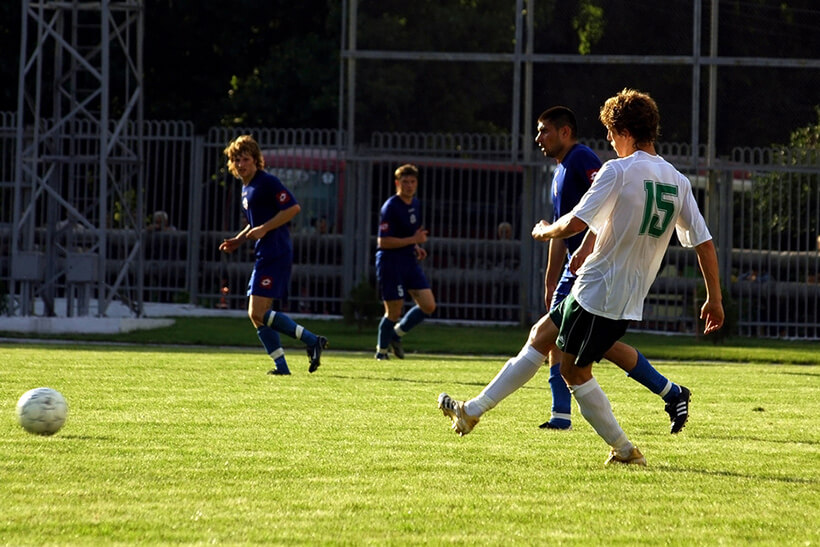Keeping possession of the ball requires just the right amount of technique and vision. It improves the overall communication of the team and it’ll downright win you games. Passing techniques are your bread and butter from now on, so you better start working on them if you want to become a pro soccer player.
This short guide will give you some general tips but also focus on specific passes you’ll need to master in order to move the ball out of pressure and into space. You can then expand on it by consulting some of the handy soccer training programs available online.

General Passing Tips
In order to master passing, you’ll have to work on your ball control a lot! Moreover, you’ll also have to improve your first touch. Remember, you can practice the wrong technique all you want and you’ll never develop a killer pass.
We can’t emphasize enough the importance of a perfect first touch, so make it your mission until you’re ready for the advanced stuff. The best way of practicing it is, surprisingly, to juggle a ball or “keep uppy” (yeah, we know how it sounds).

Flamboyant showing-off aside, juggling does have a practical benefit, which is developing spot-on ball control. You have to cushion the landing and push the ball back into the air while controlling your power. Just make sure your eyes are riveted to the ball at all times. You can make it harder by alternating your feet.
Individual passing drills will also do wonders for your technique. Find a neat wall and stick to it like you’re holding on for dear life. Draw some circles on the wall at different heights (ground, shin, chest) and try to hit them all with your passes.
Keep moving at all times and pass the ball at varying angles and distances from the wall. This will hone your passing range, but accuracy as well. The wall is a perfect “team mate” because the ball will bounce back, allowing you to work on your receiving skills as well.
Start slow, make sure your technique is solid, and don’t get all bummed out if you miss a lot of circles. If you knew this, you wouldn’t be practicing in the first place, right?
Specific Passes
Listen up, this is your future passing arsenal speaking:
- Push pass – This is your main weapon. Game in, game out, you can use it in every single position. The pass is executed with the inside of your foot. Remember to bend your knees and land your planting foot a foot next to the ball and point it in the serving direction.
- Chip pass – No, you won’t be getting any chips here anytime soon. In order to do this versatile pass, just fix on your target, get under the ball for a lofted pass, determine the shooting point with your plant foot, keep your hips square to the target and your foot flexed, and make sure to follow through so the ball wouldn’t lose its momentum.
- Driven pass – This pass should be hit like you really mean it. It’s generally used to cover larger areas, so it demands both strength and technique. The basics are still here, keep your head down and make sure you point your plant foot in the direction of your pass. Your toe should be pointed to the ground and your leg and foot flexed at all times. The middle of the ball is the bullseye, so you hit it with your laces as hard as you can and remember to follow through. Threading the needle, switching the play or capitalizing on a quick counter is where your driven balls will be at their best.
- Wall pass – What’s up with soccer and walls, right? This move is also called a “one-two pass” or “give and go” and it’s one of the most brutal combos when executed properly. It’s designed to exploit the empty space behind the defenders by combining with your teammates in the attacking area. Make sure you draw in the defender and trick him/her like you’re gonna send the pass in a different direction. Start sprinting and don’t play the ball until you have at least half a step on your defender. Hit it firmly, so the one-two can bring it back as soon as possible. This pass allows you to create even more space by simply pushing the ball in front with your first touch.
- Long pass – The “big ball” is also a very versatile tool, allowing you to relieve pressure, attack or play a teammate in. If the middle of the park is your ground, this will be your main tool for soccer passing. Center midfielder, center back, and goalies should pay special attention to this tool right here. This pass requires you to hit the ball without holding anything back. It also requires an exaggerated follow through, with your leg and body working as one. Make sure to land on your kicking foot after the said follow through.
- Weighted pass – This pass requires the most finesse and balance of them all. If it’s a tad too weak or hard, it’s practically useless and makes you look ridiculous on top of it. A weighted ball is generally played into space in front of your closest teammate, allowing them to run on to it rather quickly. This definitely shouldn’t be the first pass you practice since it takes a fine touch and not a small amount of precision. Calculate the space in front of your teammate and just play the ball into their path. Try your best to disguise the pass and remember that too long is much better than too short. This pass is easier collected on the ground so don’t go too crazy, just keep it low and direct it with your planting foot.
- Back heel pass – This is your final lesson grasshopper and it should be attempted only after you’ve mastered all the other passes. It takes a lot of practice and shouldn’t be performed unless perfected since it’ll result in you giving the ball away more often than not. The best thing about this pass is its element of surprise. If done correctly, it’ll confuse the defenders most of the time. Make sure your foot is flexed or you’ll miss the ball. For top accuracy, aim for the very center of the ball. Remember that there’s no such thing as a long back heel pass. Execute it as quickly as possible or you risk your pass being read and stolen. Don’t harp on it too much or you’ll wear off the element of surprise.
